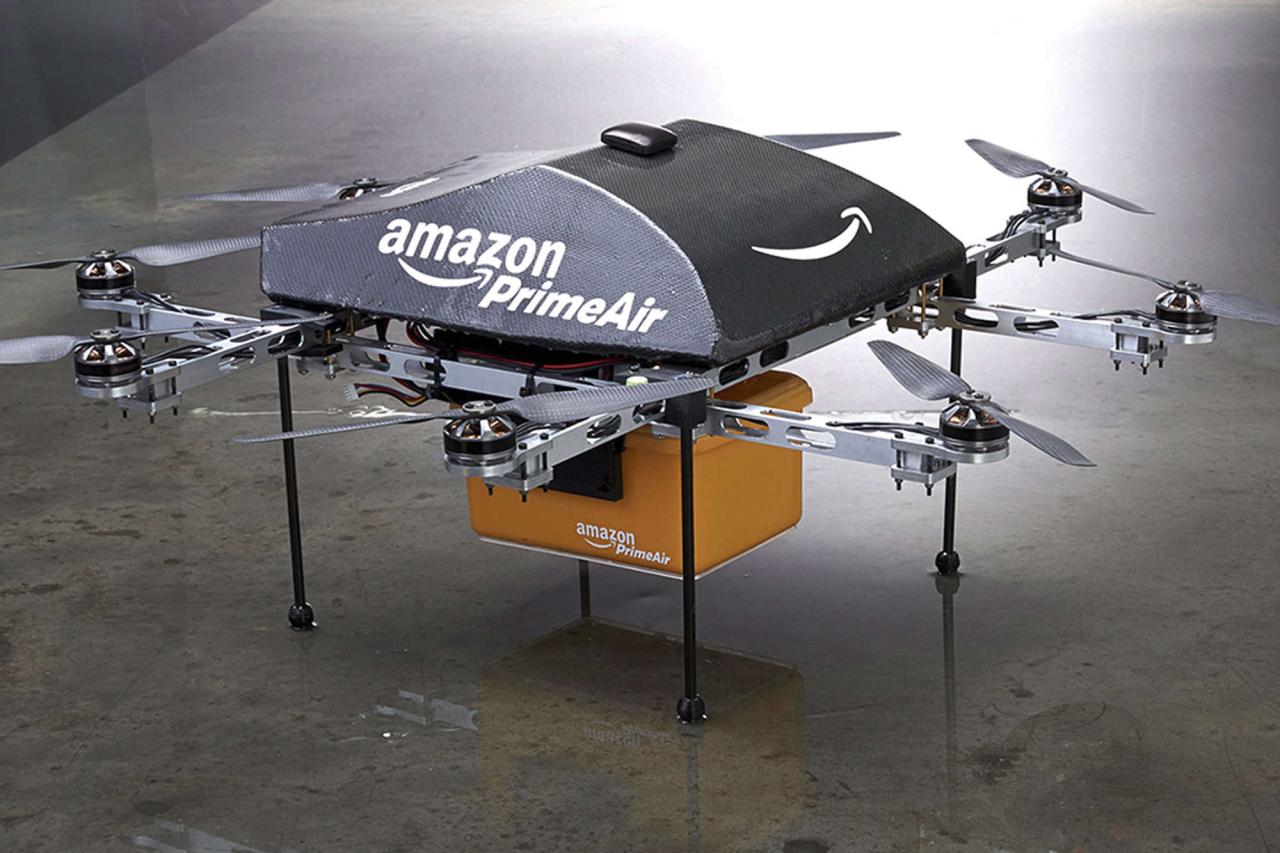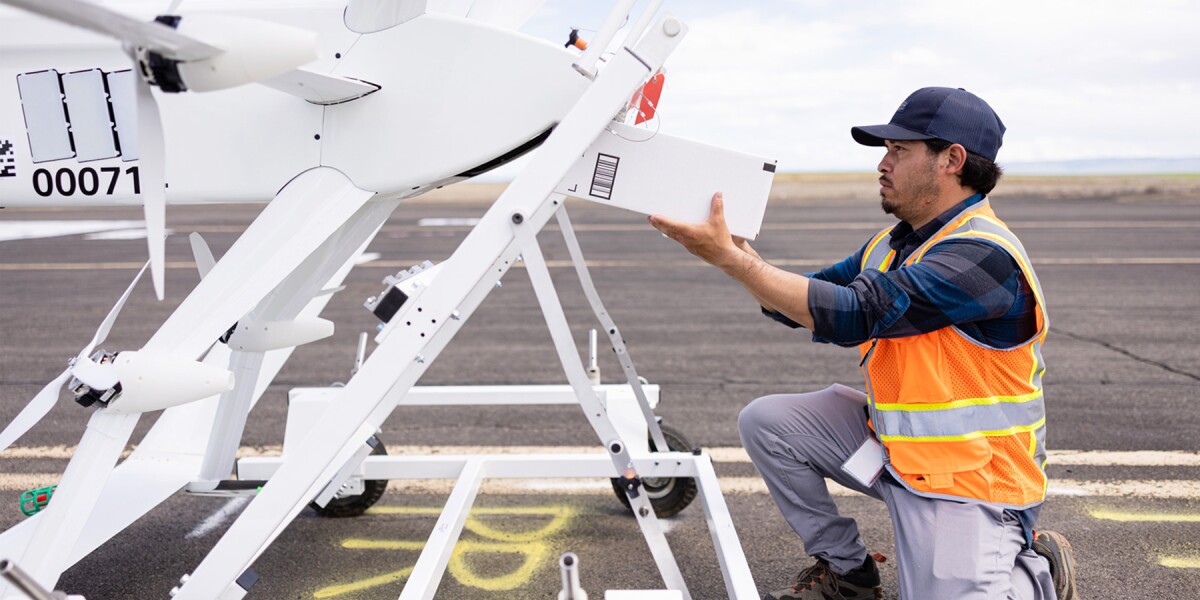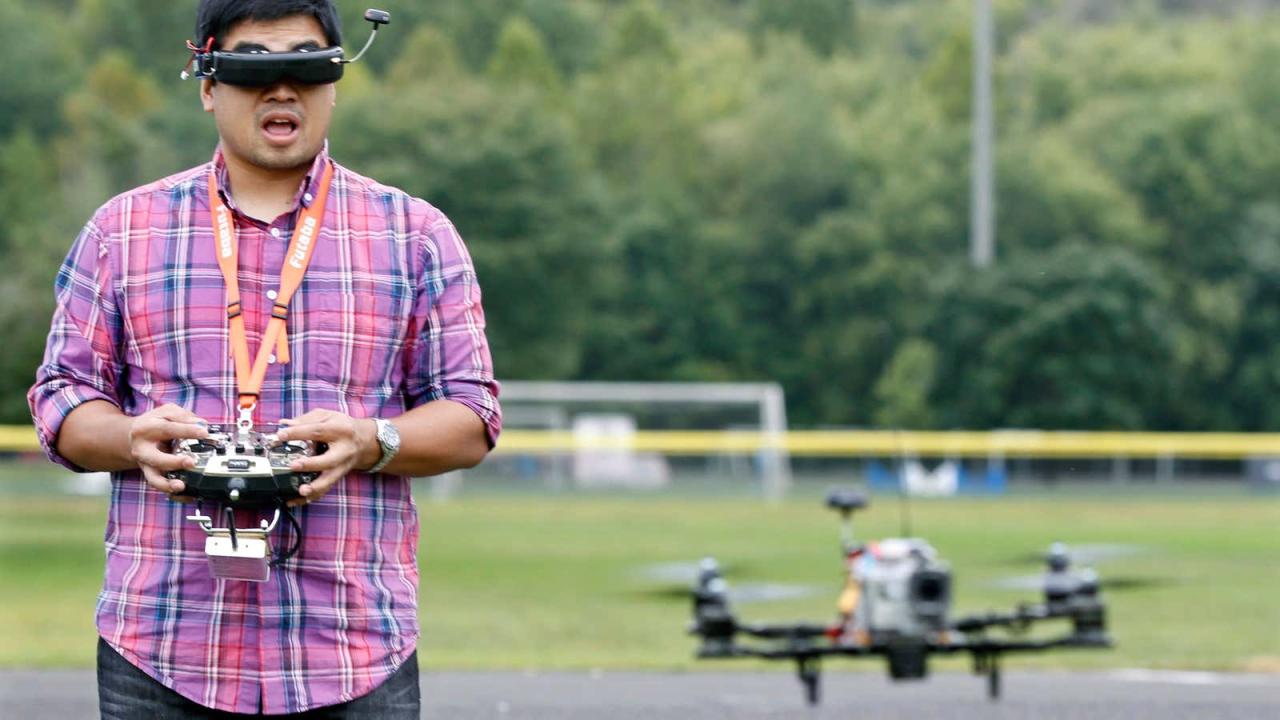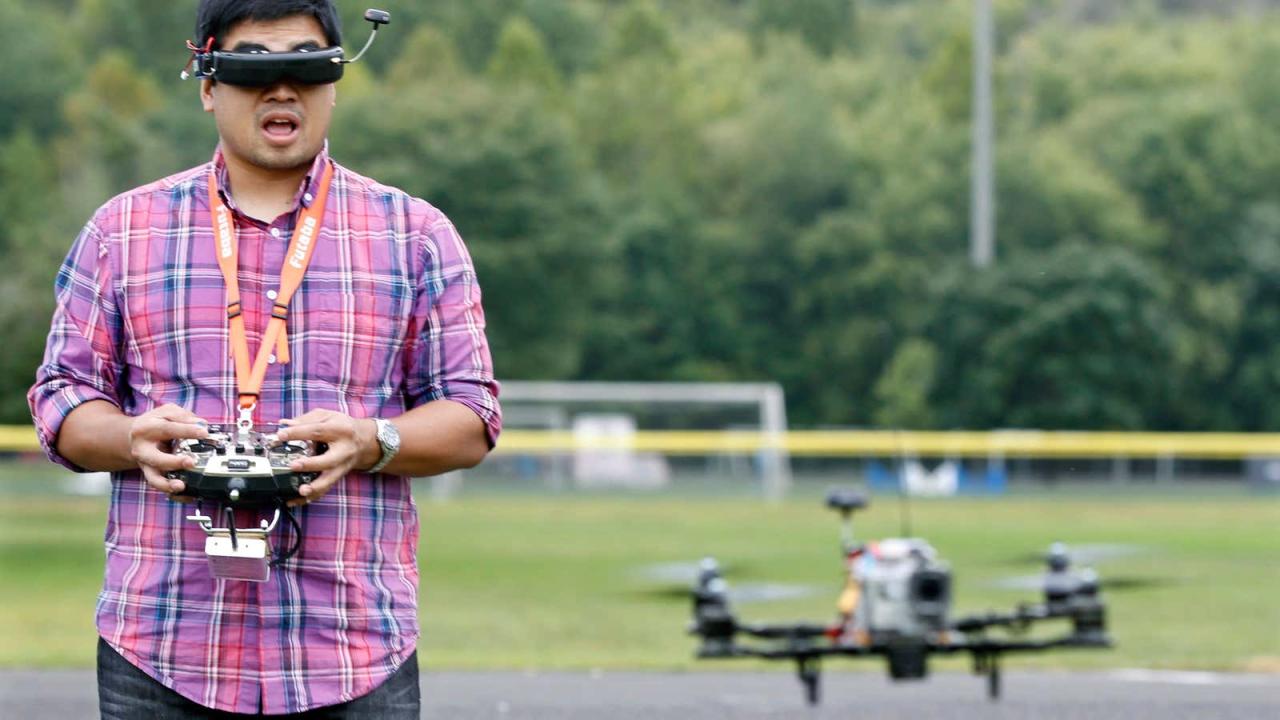Amazon drone delivery locations are rapidly changing the landscape of package delivery. This exploration delves into the current status, technological underpinnings, community impact, and future potential of this innovative system. We’ll cover everything from the selection criteria for delivery locations to the technological marvels that make it all possible, and even address some common concerns and questions. Get ready for a fascinating look at the future of shipping!
We’ll examine the current geographical reach of Amazon’s drone delivery program, detailing which types of packages are eligible and the infrastructure necessary to support these operations. Understanding the factors influencing location selection—from population density and airspace regulations to logistical considerations—is key to grasping the full scope of this ambitious project. We’ll also explore the technological innovations driving drone delivery, examining safety protocols, automated systems, and the overall efficiency of this emerging technology.
Current Amazon Drone Delivery Program Status
Amazon’s drone delivery program, officially known as Amazon Prime Air, is still in its relatively early stages, but it’s steadily expanding its reach and capabilities. While not yet a widespread service, it represents a significant step towards faster and more efficient delivery options for certain customers. The program’s current status reflects a careful, phased rollout focused on refining technology and infrastructure before broader implementation.Amazon Prime Air’s geographical scope is currently limited.
The service operates in select areas within the United States, primarily focusing on suburban and rural locations. This strategic approach allows Amazon to test and optimize its drone delivery system in controlled environments before expanding to more densely populated urban areas, which present greater logistical challenges.
Eligible Package Types for Drone Delivery
Currently, Amazon Prime Air primarily handles smaller packages weighing under five pounds. These typically include everyday items like household goods, small electronics, and books. Larger, heavier, or fragile items are not yet suitable for drone delivery due to limitations in the drone’s carrying capacity and the need to ensure safe and reliable transport. This selection of eligible items is likely to expand as drone technology and safety protocols improve.
Infrastructure Requirements for Amazon Drone Delivery Locations
Establishing a location for Amazon drone delivery requires specific infrastructure considerations. First, the location needs to have suitable airspace, free from significant obstacles like tall buildings or dense tree cover. Amazon also requires access to a designated launch and landing site, often located on a relatively flat and open area near the delivery zone. This site needs to be secure and equipped with necessary safety features to ensure safe drone operations.
Furthermore, the area needs reliable internet connectivity for real-time monitoring and control of the drones. The precise infrastructure requirements may vary depending on the specific location and environmental factors.
Delivery Time Comparison: Drone vs. Traditional Methods
Drone delivery offers significantly faster delivery times compared to traditional ground-based methods, especially for customers located in areas with limited road access or congested traffic. While exact delivery times vary depending on distance and other factors, drone deliveries can often be completed within minutes or a few hours, whereas traditional deliveries might take a day or more. For example, a package delivered via drone to a rural customer might arrive within an hour, whereas the same package delivered by truck could take a full day.
This speed advantage is a key benefit of Amazon’s drone delivery program, offering a superior customer experience in select areas.
Factors Influencing Location Selection for Drone Delivery: Amazon Drone Delivery Locations
Amazon’s drone delivery program, while ambitious, relies heavily on strategic location selection. The choice of delivery areas isn’t arbitrary; it’s a complex process balancing various factors to ensure efficient, safe, and legally compliant operations. Several key considerations are crucial for determining the viability of a given location for drone delivery.
Population Density and Delivery Demand
High population density doesn’t automatically translate to suitability. While a dense population indicates a higher demand for deliveries, it also presents challenges like increased airspace congestion and potential safety hazards. Amazon needs to balance high demand with the logistical feasibility of managing numerous drone flights in a confined area. For example, a densely populated urban center with narrow streets and tall buildings might be less suitable than a suburban area with more open space, even if the overall population is lower.
The ideal scenario involves a population density that allows for efficient delivery routes without compromising safety.
Airspace Regulations and Infrastructure
Airspace regulations are paramount. The Federal Aviation Administration (FAA) imposes strict rules on drone operations, including altitude restrictions, flight paths, and pilot certification. Areas with complex airspace, such as those near airports or military bases, may be unsuitable for drone delivery due to safety concerns and regulatory limitations. Existing infrastructure also plays a significant role. The presence of well-maintained communication networks, such as reliable cellular and GPS signals, is essential for drone navigation and control.
Areas with weak or unreliable infrastructure are less likely to be chosen for drone delivery operations.
Logistics and Infrastructure for Drone Operations
Beyond airspace, ground infrastructure is crucial. Amazon needs designated launch and landing sites, secure facilities for drone maintenance and charging, and efficient systems for package handling. The availability of suitable land, accessibility for maintenance vehicles, and proximity to transportation networks all contribute to a location’s suitability. For instance, a location near a major highway might be preferable for easy access and quicker response times for maintenance or emergencies.
The presence of well-maintained roads and other transportation links is important for supporting drone operations.
Urban versus Suburban/Rural Areas
Urban areas present both opportunities and challenges. High population density translates to significant delivery demand, but navigating congested airspace and finding suitable launch and landing sites can be difficult. Suburban and rural areas offer more open airspace and potentially easier logistical management, but the lower population density might limit the overall delivery volume and economic viability. Amazon likely prioritizes a balanced approach, targeting areas with a combination of population density and favorable airspace and logistical conditions.
A successful strategy might involve focusing on suburban areas with relatively high population densities and suitable infrastructure before expanding to more challenging urban environments.
Technological Aspects of Amazon Drone Delivery Locations

Amazon’s drone delivery program relies on a sophisticated network of technologies to ensure safe and efficient operations. These technologies span various aspects, from flight management and monitoring to package handling and delivery processes. This section details the technological infrastructure supporting Amazon’s drone delivery locations.
Drone Flight Management and Monitoring
Amazon employs a comprehensive system for managing and monitoring drone flights within designated delivery areas. This involves a combination of GPS tracking, real-time data analysis, and sophisticated flight control algorithms. Each drone’s location and flight path are continuously monitored from a central control center, allowing for immediate intervention if necessary. The system also incorporates weather data and airspace restrictions to ensure safe flight operations.
Air traffic control integration and communication protocols are crucial for avoiding collisions and maintaining airspace integrity. Data from multiple sensors on board the drones, such as altitude, speed, and battery level, are transmitted back to the control center, providing a real-time overview of each drone’s status. This data informs decision-making, allowing for proactive adjustments and preventing potential issues.
Safety Protocols and Measures at Drone Delivery Locations
Safety is paramount in Amazon’s drone delivery operations. Designated delivery locations incorporate several safety protocols and measures. These include geofencing, which restricts drone flights to pre-defined areas, and obstacle avoidance systems, which utilize sensors and algorithms to detect and navigate around obstacles. Emergency landing procedures and fail-safe mechanisms are integrated into the drone’s flight control system. The locations themselves are often chosen for their relative safety and lack of significant obstacles, minimizing the risk of accidents.
So, Amazon’s planning drone delivery in a bunch of places, right? It’s all about speed and efficiency. But, thinking about safety, you have to consider incidents like the one described in this article about a paris drone crash , which highlights the potential risks. Therefore, choosing the right locations for these deliveries is super important for Amazon to avoid similar incidents and build trust.
Regular maintenance and inspections of drones and supporting infrastructure are also vital to maintaining safety standards. Furthermore, comprehensive training for drone pilots and maintenance personnel is a key element of the safety program.
Package Handling and Delivery Processes
The process of package handling and delivery at Amazon drone delivery locations involves a degree of automation. Packages are typically sorted and loaded onto drones using automated systems at a central hub. The drones themselves utilize automated flight paths and delivery mechanisms, including precision landing systems and automated package release mechanisms. Once a drone reaches its designated delivery location, the package is released using a mechanism designed to ensure safe and accurate delivery.
The entire process, from package loading to delivery, is monitored in real-time, allowing for rapid response to any unforeseen issues. In some cases, a combination of automated and manual processes might be used, depending on the specific location and delivery requirements.
Technological Components in a Single Drone Delivery Operation
The following table illustrates the key technological components involved in a single Amazon drone delivery operation.
| Component | Description | Function | Interaction with Other Components |
|---|---|---|---|
| Drone (UAV) | Autonomous flying vehicle equipped with GPS, sensors, and a package compartment. | Transportation of the package to the delivery location. | Communicates with the control center, utilizes GPS data for navigation, and interacts with package release mechanism. |
| Control Center | Centralized facility monitoring all drone flights in real-time. | Oversees drone operations, manages flight paths, and responds to emergencies. | Receives data from all drones, interacts with weather and airspace data systems. |
| GPS Navigation System | Provides precise location data for drone navigation. | Guides the drone to the delivery location and ensures accurate positioning. | Integrated into the drone’s flight control system and communicates with the control center. |
| Automated Package Handling System | System for loading and unloading packages onto drones. | Ensures efficient and safe package handling. | Interacts with the drone’s package compartment and the central warehouse system. |
Community Impact and Public Perception of Drone Delivery Locations

Amazon’s drone delivery program, while technologically impressive, significantly impacts the communities where it operates. Understanding public perception and the program’s broader community effects is crucial for its long-term success and responsible implementation. This section explores the multifaceted relationship between drone delivery and the communities it serves.Amazon’s community engagement strategies vary depending on the location, but generally involve proactive communication and information sharing.
For example, in some areas, Amazon has held public forums and town hall meetings to address residents’ concerns and answer questions directly. They may also distribute informational brochures or utilize local media outlets to disseminate information about the program. This approach aims to build trust and transparency, fostering a more positive community response.
Amazon’s expanding drone delivery network is aiming for wider coverage, but safety is key. Recent news reports, like this article on drone crashes in Paris , highlight the potential risks involved in widespread drone use. Understanding these challenges is crucial for ensuring the safe and efficient expansion of Amazon’s drone delivery locations in the future.
Community Concerns Regarding Drone Delivery
Residents often express concerns about the potential negative impacts of drone delivery. Noise pollution is a primary concern, with the whirring of drone propellers potentially disrupting the peace and quiet of residential neighborhoods, especially during early morning or late evening deliveries. Privacy is another significant issue, as some residents worry about drones potentially capturing images or video of their homes and property.
Safety concerns, such as the possibility of drones malfunctioning and causing damage or injury, are also frequently raised. These concerns highlight the need for careful planning, robust safety protocols, and ongoing community dialogue.
Economic Impact of Drone Delivery on Local Communities
The economic impact of drone delivery is a complex issue with both potential benefits and drawbacks. On the one hand, drone delivery could create new jobs in areas such as drone maintenance, operation, and logistics. It could also benefit local businesses by providing a faster and more efficient delivery option, potentially increasing sales and expanding their reach. However, the economic impact might not be evenly distributed, and some existing jobs in traditional delivery services could be displaced.
The long-term effects on local employment and the overall economic landscape will require ongoing monitoring and analysis. For instance, a small town reliant on traditional courier services might experience job losses if drone delivery supplants those roles, while a larger city with a robust logistics sector might see more of a net benefit.
Benefits and Drawbacks of Drone Delivery for Communities
It’s important to weigh the potential benefits and drawbacks of drone delivery for communities.
Amazon’s expanding drone delivery network is pretty cool, aiming to reach more locations soon. However, incidents like the one described in this article about the orlando drone show accident highlight the importance of safety and robust regulations for all drone operations. These kinds of accidents underscore the need for thorough testing and fail-safes before widespread drone delivery becomes the norm.
- Benefits: Faster delivery times, reduced traffic congestion, increased accessibility to goods and services in remote areas, potential for job creation in new industries.
- Drawbacks: Noise pollution, privacy concerns, safety risks associated with drone malfunctions, potential job displacement in traditional delivery sectors, increased energy consumption.
Future Expansion and Potential of Amazon Drone Delivery Locations
Amazon’s drone delivery program is still in its relatively early stages, but its potential for future expansion is enormous. Several factors, including technological advancements and evolving regulatory landscapes, will shape its growth trajectory in the coming years. This section explores the likely expansion areas, key technological enablers, potential challenges, and a projected timeline for this exciting development.
Potential Future Expansion Areas
Current drone delivery operations are concentrated in areas with relatively low population density and favorable weather conditions. Future expansion will likely target suburban and rural communities underserved by traditional delivery methods. We can expect to see a significant increase in drone delivery services in areas with strong e-commerce activity but limited ground transportation infrastructure. Think of sprawling suburban developments, remote island communities, or sparsely populated agricultural regions.
Amazon might prioritize areas with existing logistical infrastructure, making integration smoother. For example, existing fulfillment centers strategically located to support drone delivery operations could be leveraged, reducing overall delivery times and costs.
Technological Advancements Expanding Drone Delivery Reach
Several technological advancements are poised to dramatically increase the reach and efficiency of drone delivery. Improved battery technology will allow drones to cover greater distances on a single charge, opening up vast new areas for delivery. Advanced autonomous navigation systems, utilizing AI and machine learning, will enhance drone safety and reliability in complex environments. The development of drone-specific air traffic management systems will enable safer and more efficient integration of drones into existing airspace.
Imagine drones capable of autonomous flight in all weather conditions, navigating around obstacles with ease, and delivering packages with pinpoint accuracy – that’s the potential. Furthermore, the development of hybrid drone systems, combining the benefits of both vertical takeoff and landing (VTOL) and fixed-wing aircraft, could significantly extend range and payload capacity.
Challenges Hindering Future Expansion, Amazon drone delivery locations
Despite the significant potential, several challenges could hinder the expansion of drone delivery. Regulatory hurdles, including airspace regulations and licensing requirements, remain a significant obstacle. Public acceptance and concerns about safety and privacy need to be addressed through effective communication and robust safety protocols. Infrastructure limitations, such as the need for charging stations and maintenance facilities, also pose challenges.
The integration of drone delivery into existing logistics networks requires careful planning and coordination. Addressing cybersecurity vulnerabilities and protecting sensitive data transmitted during drone operations is also critical. Finally, the potential for accidents and their impact on public perception will need ongoing mitigation strategies.
Projected Timeline for Expansion
The following timeline illustrates potential milestones in the future expansion of Amazon’s drone delivery network. This is a projection and actual timelines may vary based on technological advancements and regulatory approvals.
| Year | Milestone |
|---|---|
| 2024-2025 | Expansion into more suburban areas; improved drone autonomy and weather resilience. |
| 2026-2028 | Significant increase in delivery volume; introduction of hybrid drone systems; expansion into rural and remote areas. |
| 2029-2032 | Integration of drone delivery into broader logistics network; potential for international expansion; development of advanced air traffic management systems. |
Illustrative Example
Let’s imagine a typical Amazon drone delivery location in a suburban setting. This example will detail the features, infrastructure, and operational processes involved, highlighting how the surrounding environment influences drone operations. We’ll focus on a location designed for efficient and safe delivery, minimizing disruption to the community.
Location Description
The chosen location is a small, fenced-in area approximately 20 feet by 20 feet, situated in a quiet residential area near a park. It’s located on a small parcel of land owned by Amazon, adjacent to a larger commercial property, but far enough away from busy roads to minimize the risk of collisions. The land is relatively flat and level, crucial for safe drone landings and takeoffs.
The surrounding area is characterized by single-family homes with ample open space between them, providing clear airspace for drone navigation. The park nearby acts as a natural buffer zone, further mitigating potential hazards. The fence surrounding the delivery location is approximately six feet high, constructed from chain-link with a locked gate, ensuring security and preventing unauthorized access.
Drone Landing Pad and Infrastructure
The central feature is a helipad-style landing pad, approximately 10 feet in diameter, made of durable, non-slip material. It is clearly marked with bright, highly visible reflective paint, including Amazon’s logo and directional arrows to guide the drone. Integrated into the pad is a small, weatherproof charging station for the drone batteries. A small, weatherproof control box sits nearby, housing the communication equipment and sensors needed for drone operations.
The box is secured and tamper-proof. The entire area is well-lit with LED lights, ensuring visibility both during the day and at night.
Safety Features
Several safety features are incorporated into the design. Besides the fence, there are also height-restriction markers placed around the perimeter to alert nearby pilots of low-flying drones. The landing pad itself is designed to absorb impact in case of an unexpected landing. Sensors constantly monitor wind speed and direction, and the system is programmed to automatically abort a landing if conditions are unsafe.
Emergency contact information is clearly displayed on the control box and the fence. The location is also monitored remotely by Amazon’s control center, which can intervene in case of emergencies.
Surrounding Area Impact
The location’s proximity to residential areas necessitates careful consideration of noise levels. The drones used are specifically designed to be relatively quiet, and flight paths are optimized to minimize noise pollution. Regular noise level monitoring is conducted to ensure compliance with local regulations. The location’s design minimizes visual obstruction to nearby residents. The relatively small size and neutral color scheme of the landing pad and infrastructure blend seamlessly into the surrounding environment.
The impact on the community is carefully considered and monitored through regular feedback mechanisms.
Conclusion

Amazon’s drone delivery program is a dynamic and rapidly evolving system, poised to revolutionize package delivery. While challenges remain, the potential benefits—from faster delivery times to reduced environmental impact—are undeniable. As technology advances and regulations adapt, we can expect to see a significant expansion of Amazon drone delivery locations in the coming years, transforming how we receive our online purchases.
The future of delivery is in the air, and it’s taking flight.
Questions and Answers
What is the weight limit for packages delivered via Amazon drones?
The weight limit varies depending on the drone model and regulatory restrictions, but it’s generally limited to smaller, lighter packages.
How do Amazon drones handle bad weather conditions?
Amazon drones are equipped with sensors and software that allow them to detect and avoid bad weather. Delivery is often suspended during storms or high winds.
What happens if a drone malfunctions during delivery?
Amazon has safety protocols in place, including redundant systems and emergency landing procedures. In case of malfunction, the drone is designed to land safely, and customer support is contacted.
Are there any security concerns related to Amazon drone deliveries?
Amazon employs various security measures to protect against unauthorized access and tampering, including encrypted communication and GPS tracking.
